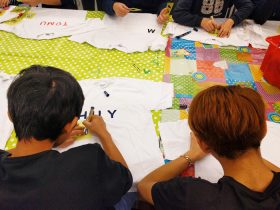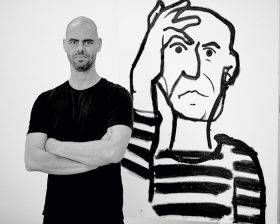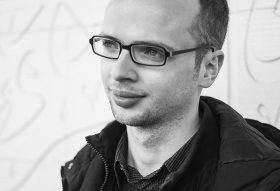Workshops for young refugees

Whether in Hebrew, Arabic, or German, there are lots of ways to write one’s name; photo: private
What’s written in a Jewish marriage contract? As a minority, how do you secure your civil rights? And why is Hanukkah celebrated for eight days? My work as a guide at the Jewish Museum isabout how to coax stories from objects on display — but also about language. The first thing I did when I began working here about four years ago was to look up how to say “ruminants with cloven hooves” in French. You need to have this phrase at the ready if you want to explain Jewish dietary laws to a group of French museum visitors. My French didn’t help much, however, when I led the first workshops in August of 2016 for Welcome Classes. → continue reading
An Interview with Eran Shakine
Today, on 27 October 2016 at 7 pm, our exhibition “A Muslim, a Christian, and a Jew” is opening with Eran Shakine in attendance. In the run-up to the opening, Gregor H. Lersch spoke with the Israeli artist about religion, art, and his sources of inspiration.

Eran Shakine; photo: Shay Kedem
Gregor H. Lersch: What does “A Muslim, a Christian and a Jew” (MCJ) show?
Eran Shakine: “A Muslim, a Christian and a Jew…” sounds like the beginning of a joke. But that is just to get your attention.
The show is an installation consisting of 40 paintings, drawings, and three metal cut-out sculptures.
The three similar figures, their religious background unidentifiable, create situations by means of a vivid and comical body language. In every drawing they witness and experience major events in history or philosophy, or meet important figures like Moses, Buddha or Nelson Mandela. The three heroes, dressed as 19th century gentlemen, help each other in their journey to find the love of God.
Here, there are no stereotypes, no one is the laughingstock, everyone is the same; we see three human beings who explore life, nature, culture and philosophy, out of shared curiosity, without trying to prove each other wrong.
Why did you start to work on MCJ? → continue reading

Ármin Langer; Foto: Kat Kaufmann
As part of the series “New German Stories,” we will present the book Ein Jude in Neukölln. Mein Weg zum Miteinander der Religionen (A Jew in Neukölln. My path to the coexistence of religions) by Ármin Langer on 19 October 2016. The author, who will be our guest on this evening, will talk about his life as a Jewish activist and his experiences as coordinator of the Berlin Salaam-Shalom initiative that sets an example of peaceful Jewish-Muslim coexistence.
We asked Ármin Langer three questions:
Alina Gromova: Ármin, you decided at the age of 21 years to become a rabbi even though you are from a secular family. What led you to this decision back then?
Ármin Langer: Already as a child I was open to religion, but this feeling found no frame until I was 20. → continue reading


